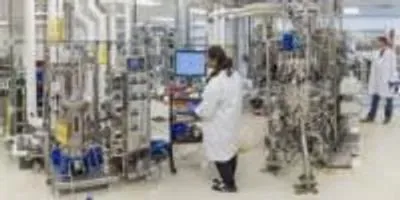 The Advanced Biofuels Process Demonstration Unit at Berkeley Lab has both helped and benefited from working with Cyclotron Road innovators.Photo Credit: Roy Kaltschmidt/Berkeley Lab
The Advanced Biofuels Process Demonstration Unit at Berkeley Lab has both helped and benefited from working with Cyclotron Road innovators.Photo Credit: Roy Kaltschmidt/Berkeley Lab
Berkeley Lab scientist Jeff Long and students in his research lab had come up with exciting new materials for doing gas separations very efficiently, including materials for removing CO2 from a gas. The discovery had great potential as a technology to reduce energy use by the chemical separation industry, but finding an investor would be next to impossible. So they brought their project to Cyclotron Road, Berkeley Lab’s program for scientists looking to advance their research to the point of commercial viability.
After about a year and a half of work in the program developing their materials, they succeeded in securing a $1.5-million investment last fall from Evok Innovations, a cleantech fund based in Canada. The work has been led by Long’s former graduate student, Tom McDonald, who now serves as CEO of Mosaic Materials, the company formed to commercialize the technology.
“Materials-based technologies tend to be slow and expensive to develop,” Long said. “There are a lot of expenses in terms of people and equipment. Most investment companies are not really looking for that kind of business. Cyclotron Road has been very helpful with a way to get started to demonstrate new technology that came out of my research lab.”
The Evok investment in Mosaic Materials is the largest single private sector deal for a Cyclotron Road project since the program’s inception two years ago. But it’s hardly the only success. The inaugural cohort of innovators—a total of six projects—has attracted more than $10 million in competitive state and federal grants, with 20 percent of that going to their Berkeley Lab collaborators. These projects have also secured more than $5 million in initial private investment, with some of that funding going to Berkeley Lab scientists through cooperative research agreements.
The program, launched as a pilot by Berkeley Lab in 2014, is now supported primarily by the Department of Energy’s Advanced Manufacturing Office.
“Not only have our innovators helped bring funding to Berkeley Lab, their scientific collaborations with Lab researchers are leading to new research directions, scientific capabilities, joint inventions, and publications,” said Ilan Gur, director of Cyclotron Road.
Related Article: Twists and Turns in Path from Lab to Startup to Major Acquisition
Visolis, for example, a Cyclotron Road project led by Deepak Dugar to produce chemicals in an efficient, carbon-negative way, has secured several Small Business Innovation Research (SBIR) awards totaling more than $1 million, including from the Department of Agriculture and Department of Energy (DOE). Much of their work has been done at the DOE’s Advanced Biofuels Process Demonstration Unit (ABPDU), a process research, development, and piloting collaboration facility run by Berkeley Lab.
The collaboration has been mutually beneficial, said ABPDU head Todd Pray. “We’re kind of a one-stop shop—you can do chemical processing, fermentation, purification, and analytical chemistry—which makes it so much easier for small companies. I think we played a key role in allowing Visolis to show their lab-scale processes make sense at a larger scale,” he said. “And our experience in working with them has added to our expertise in integrating processes all the way from biomass deconstruction through final product purification.”
Another Cyclotron Road project, Sepion Technologies, which is developing ultra-light, high-power lithium-sulfur batteries for aviation, has been awarded grants from both ARPA-E and DOE’s High Performance Computing for Manufacturing (HPC4Mfg) Program.
Sepion’s key innovation, developed at Berkeley Lab by Molecular Foundry scientists Brett Helms and Peter Frischmann, is a microporous polymer membrane to replace incumbent separator materials, which are not processable at scale and limit the power density of the battery. In the ARPA-E grant, $3.5 million will go to a team led by battery manufacturer 24M and including Sepion, Berkeley Lab, and Carnegie Mellon University.
Lab Quality Management Certificate
The Lab Quality Management certificate is more than training—it’s a professional advantage.
Gain critical skills and IACET-approved CEUs that make a measurable difference.
The Sepion team was also awarded a $155,000 grant from the HPC4Mfg program to support Molecular Foundry scientist David Prendergast , whose computer simulations can improve the manufacturability, performance, and durability of Sepion’s membranes. Sepion and Prendergast will use resources at Berkeley Lab’s National Energy Research Scientific Computing Center (NERSC), a DOE Office of Science User Facility, to address key challenges in membrane manufacturing that could lead to longer lifetimes for lithium-sulfur batteries.
Other highlights:
- Opus12, which has a technology to recycle CO2 into chemicals and fuels, was awarded $200,000 through DOE’s Small Business Voucher pilot to support Berkeley Lab’s Adam Weber, a fuel cell expert in the Energy Technologies Area (ETA), in developing a computer model of their device
- Spark Thermionics was awarded $3.8 million from ARPA-E for research on a thermionic power generator. The award will fund Andreas Schmid of the Materials Sciences Division along with collaborators at three universities.
- polySpectra founder Raymond Weitekamp was a recipient of an ARPA-E award of nearly $4 million supporting a collaboration with Steve Selkowitz and Arman Shebani of ETA in developing a paint-on coating for energy-efficient windows.
“Cyclotron Road is trying to fill this gap between basic fundamental discovery and being able to validate a first product,” Long said. “There’s a real gap—to get to your first round of investment you need to demonstrate certain things, and Cyclotron Road provides a mechanism for doing that.”












